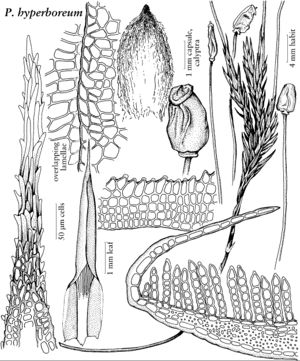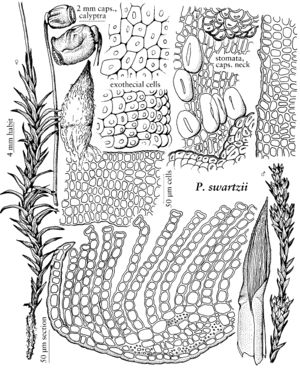Polytrichum
Sp. Musc. Frond., 88. 1801 ,.
Plants medium-sized to tall and robust, in loose to compact tufts, arising from a horizontal underground rhizome. Stems loosely to densely leafy distally, bracteate proximally, rhizoidous at base or rarely wooly-tomentose throughout. Leaves with differentiated sheath and blade; sheath entire, hyaline-margined, often highly nitid (glossy), with a well-developed hinge-tissue at the junction of sheath and blade; marginal lamina narrow, plane or erect, sharply toothed with stout, unicellular teeth, or entire, broadened and ± sharply inflexed, enclosing the lamellae; costa short-excurrent or prolonged as a long, spinulose awn; lamellae numerous, closely-spaced, the marginal cells in section distinctly differentiated, pyriform, flattopped, or retuse, smooth. Sexual condition dioicous; male plants with conspicuous rosettes formed by the broadly overlapping, apiculate perigonial bracts, commonly innovating and producing several successive male inflorescences per shoot; perichaetial leaves typically long-sheathing, the sheath broadly hyaline-margined, with a weakly-developed and greatly abbreviated blade. Seta solitary. Capsule 4 (–5) -angled, often somewhat broader toward the base, alate and prismatic with knife-edge angles after the operculum shed, reddish to purplish brown, glaucous in fresh capsules, suberect when young but becoming sharply bent at the attachment to the seta and almost horizontal; hypophysis discoid, sharply delimited from the urn by a deep basal constriction; stomata rather few and confined to the constriction; exothecial cells bulging-mammillose, often transversely elongate, with a sharply defined, circular or slitlike pit in the outer wall; operculum umbonate, with a short beak; peristome teeth 64, pale, single, with a thin vertical keel and delicate spurlike projections in the inner face; epiphragm thin and delicate, remaining attached to the peristome teeth, the margin thicker and dissected into pendent lobes alternating with the peristome teeth. Calyptra with a densely interwoven, matted felt of hairs, enveloping the whole capsule and entwined beneath. Spores small, smooth (minutely echinulate with SEM).
Distribution
Cosmopolitan
Discussion
Species ca. 70 (7 in the flora).
Polytrichum is characterized by a unique set of tightly correlated sporophytic characters. The capsules are sharply angled with a discoid hypophysis separated from the body of the capsule by a deep basal constriction, and a glaucous appearance when fresh (see E. Lawton 1971, frontisp.). The exothecial cells are bulging-mammillose, with a sharply-defined pit, and the peristome and epiphragm are of the pterygodont type (S. O. Lindberg 1868; Gary L. Smith 1971, 1974). Polytrichum species are distinct genetically from other members of the family, suggesting an early origin for this lineage. Capsules with bulging-mammillose, pitted exothecial cells, discoid hypophysis, and spores echinulate with “Christmas-tree” projections are already present in the Late Cretaceous fossil genus Eopolytrichum (A. S. Konopka et al. 1997). Two groups of Polytrichum species are represented in our area, one with narrow, toothed, ± erect leaf margins (sect. Polytrichum), and the other with broad, entire, sharply inflexed leaf margins, enclosing and sheltering the adaxial lamellae (sect. Juniperifolia).
Selected References
None.
Lower Taxa
Key
| 1 | Marginal lamina narrow, mostly erect, the margins sharply toothed to subentire; cells of the marginal lamina ± isodiametric | > 2 |
| 1 | Marginal lamina broad, membranous, sharply inflexed and overlapping, enclosing the lamellae, the margins entire or minutely crenulate; cells of the marginal lamina transversely elongate-rectangular, thick-walled | > 4 |
| 2 | Marginal cells of lamellae in section single or geminate, usually broader than tall, rounded-quadrate, flat-topped or asymmetrical, the margin flat-topped or shallowly crenulate, without projecting knobs. | Polytrichum swartzii |
| 2 | Marginal cells of lamellae in section single, retuse to distinctly notched (rarely divided by a vertical partition), the margin distinctly grooved as seen from above, with 2 rows of paired, projecting knobs | > 3 |
| 3 | Stems (2-)5-10(-70) cm; leaves with blade squarrose-recurved when moist, not caducous, margins strongly toothed; capsule rectangular. | Polytrichum commune |
| 3 | Stems 3-12 cm; leaves straight or weakly recurved when moist, the blade caducous, margins entire or finely serrulate; capsule short-rectangular to cubic. | Polytrichum jensenii |
| 4 | Leaf sheath ovate; blade abruptly contracted to a long, hyaline awn. | Polytrichum piliferum |
| 4 | Leaf sheath elliptic to rectangular; blade tapering to a short brownish or bicolored awn | > 5 |
| 5 | Plants fastigiately branched; awns roughly toothed at the base, bicolored, reddish brown at base, hyaline in distal 1/2; marginal cells of lamellae ovoid, ± thin-walled. | Polytrichum hyperboreum |
| 5 | Plants simple; awns roughened to subentire, concolorous, brownish throughout (or hyaline only at extreme tip); marginal cells of lamellae in section pyriform, thick-walled especially in the apex | > 6 |
| 6 | Stems brownish tomentose only near base; leaves longer, 3-6(-8) mm; capsules to 2 times longer than broad. | Polytrichum juniperinum |
| 6 | Stems densely whitish tomentose; leaves short, 2-5(-6) mm; capsules cubic. | Polytrichum strictum |
"broadened" is not a number."broader" is not a number.


